Nestled along the southwestern coast of Africa, Angola stands as a nation of enigmatic beauty and cultural richness, beckoning curious travelers to explore its hidden treasures. From its dramatic landscapes to its vibrant cities, Angola’s fame resonates with a blend of natural wonders, historical significance, and untapped potential.
With a history that weaves together indigenous heritage and colonial influences, this Southern African gem offers a rich tapestry of experiences just waiting to be uncovered.
One of the most enchanting aspects of this region is the charm of LA’s parks, where you can immerse yourself in the natural beauty and cultural diversity that Los Angeles is known for. Explore more about the allure of this iconic city on the page What is Los Angeles Known For.
Angola’s unique position on the world stage is a testament to its diverse attractions that range from sprawling national parks to dynamic urban hubs. When it comes to diverse and remarkable destinations, few places can rival the highlights of Idaho. From its breathtaking natural wonders to its vibrant cultural scene, Idaho offers a rich tapestry of experiences for travelers.
Its allure extends beyond its geographical borders, as Angola’s music, dance, and cuisine have gained international recognition for their infectious charm.
As we delve into the depths of this article, we’ll unveil the myriad facets that contribute to Angola’s fame, painting a vivid picture of a nation that holds both tradition and modernity in harmonious embrace.
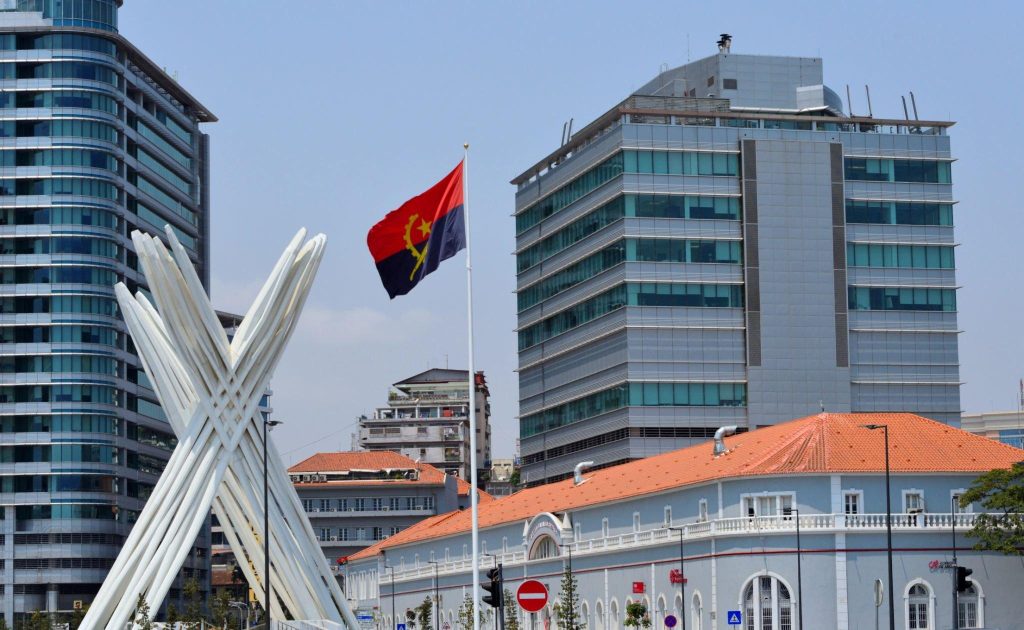
Contents
- 1 When to Visit Angola
- 2 Valley of the Moon Viewpoint or Miradouro da Lua
- 3 Sangano Beach
- 4 Cabo Ledo
- 5 Quissama or Kissama National Park
- 6 Lubango to Namibe
- 7 The Giant Sable was Rediscovered Here
- 8 Angola is Extremely Youthful
- 9 Angola is the Seventh Largest Country in Africa
- 10 Angola is Home to a Pretty Impressive Waterfall
- 11 Exploring Luanda: The Capital City
- 12 The Allure of Angolan Cuisine
- 13 The Rhythms of Angolan Music and Dance
- 14 Untapped Tourism Potential
- 15 Conclusion:
When to Visit Angola
When planning a visit to the captivating nation of Angola, timing plays a pivotal role in ensuring a memorable and enjoyable experience. The country’s climate exhibits distinct variations across its regions, influencing the best times to explore its diverse landscapes and engage in various activities. To discover more about the remarkable traits of Oklahoma, be sure to visit our page on OKC’s Remarkable Traits.
The optimal time to visit Angola is during the dry season, which typically spans from May to October. These months offer the most favorable weather conditions, characterized by warm temperatures and minimal rainfall.
This climate is especially conducive for outdoor adventures, wildlife exploration, and sightseeing, as you can explore Angola’s natural wonders without the hindrance of heavy rains.
Valley of the Moon Viewpoint or Miradouro da Lua
Nestled within the heart of Angola’s captivating landscape, the Valley of the Moon Viewpoint, locally known as Miradouro da Lua, is a natural wonder that beckons visitors with its otherworldly beauty.
Just a short drive from the capital city of Luanda, this unique geological formation offers a glimpse into an alien-like terrain, reminiscent of the lunar surface. As you approach the viewpoint, the rugged expanse of eroded clay and sandstone formations comes into view, creating an awe-inspiring sight that has earned it the moniker “Moon Viewpoint.”
The Valley of the Moon, nestled in the heart of Indiana, is a sanctuary that beckons photographers and adventure enthusiasts with its captivating vistas. It provides an exceptional canvas for preserving cherished moments and crafting enduring memories. If you’re eager to explore more of Indiana’s cultural treasures, be sure to check out our article on “Indiana’s cultural treasures” for further inspiration.
The reddish-brown hues of the landscape, coupled with the play of light and shadow, create a surreal ambiance that changes with the shifting sun. The sight of these remarkable rock formations, shaped by millennia of wind and water erosion, evokes a sense of wonder and exploration.
Sangano Beach
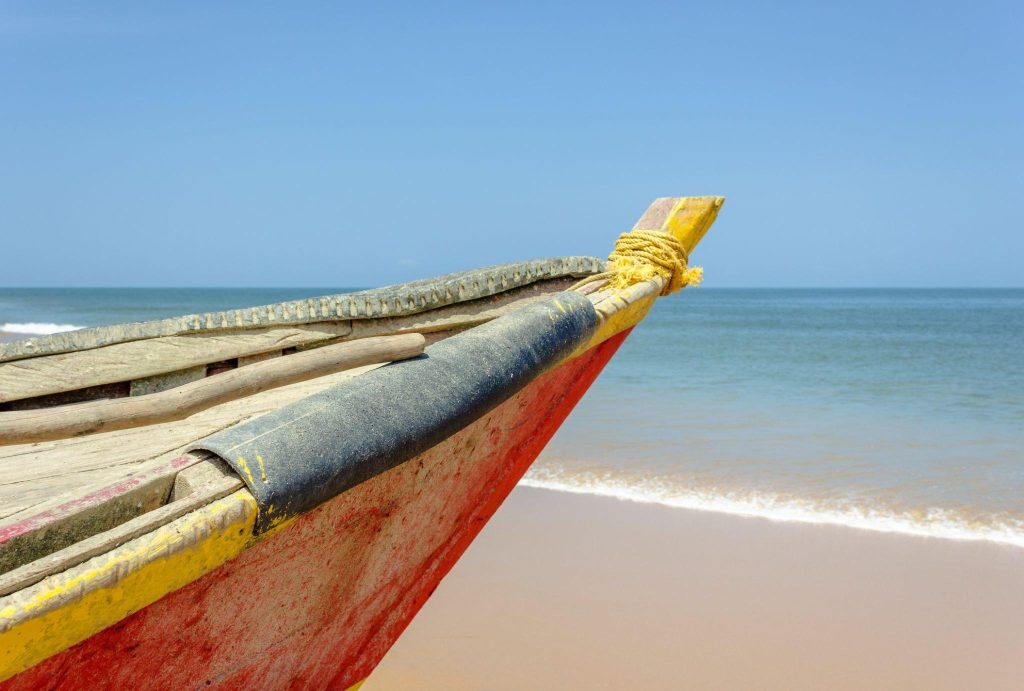
Nestled along the pristine coastline of Angola, Sangano Beach emerges as a haven of serenity and natural splendor. With its powdery sands and crystal-clear waters, this beach invites visitors to escape the bustle of everyday life and immerse themselves in tranquility.
Located near the capital city of Luanda, Sangano Beach offers a convenient retreat for both locals and tourists alike.
As the waves gently lap the shore, Sangano Beach provides an ideal setting for relaxation and rejuvenation. The tranquil atmosphere allows you to unwind under the warm sun, soaking in the breathtaking views of the azure ocean.
Whether you’re strolling along the shoreline, building sandcastles, or simply basking in the coastal breeze, the beach offers a range of activities to suit every preference.
Cabo Ledo
Cabo Ledo, a coastal paradise nestled along Angola’s southwestern shores, is a haven for surf enthusiasts and nature admirers alike. This picturesque destination boasts a unique blend of stunning scenery and exhilarating waves, making it a sought-after spot for those seeking an adrenaline-filled escape.
The beach’s allure lies in its impressive waves that attract surfers from around the world, offering both beginners and seasoned pros an opportunity to ride the surging tides. As the waves crash against the golden sands, Cabo Ledo creates a mesmerizing atmosphere that beckons visitors to immerse themselves in its beauty.
Beyond its surfing fame, Cabo Ledo’s breathtaking landscapes provide a serene backdrop for relaxation and exploration. Whether you’re a thrill-seeker aiming to conquer the waves or a traveler yearning for a tranquil seaside retreat, Cabo Ledo invites you to embrace the thrill of adventure amidst nature’s splendor.
Quissama or Kissama National Park
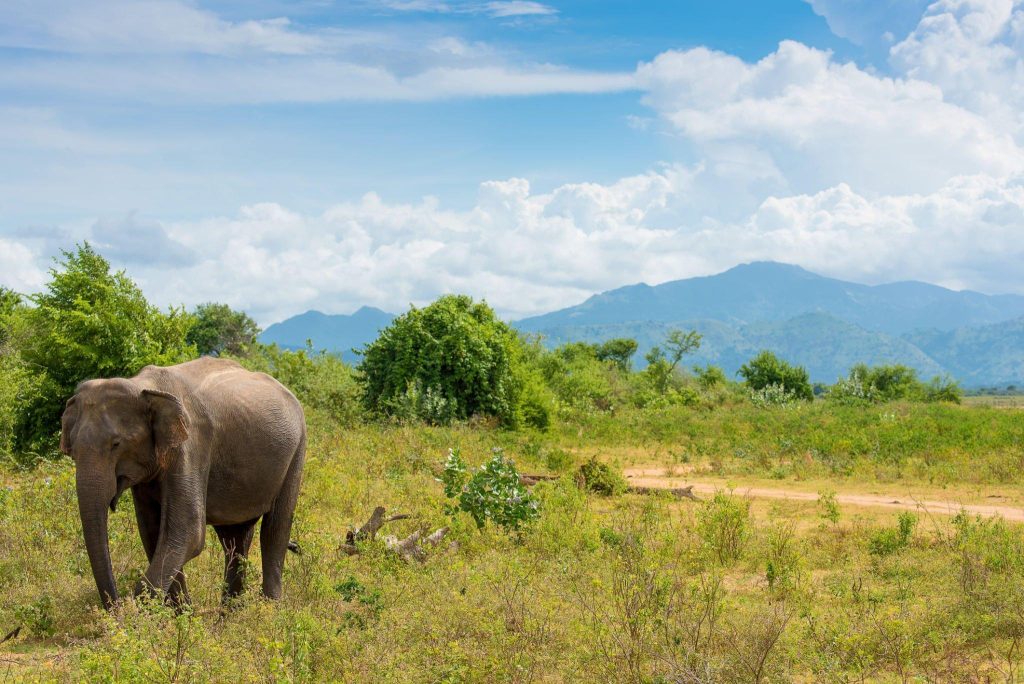
Quissama National Park, often referred to as Kissama National Park, is a true testament to Angola’s commitment to preserving its natural heritage. Spanning over 9,600 square kilometers along the country’s coastline, this park offers a sanctuary for diverse wildlife and a haven for nature enthusiasts.
Established in 1938, Quissama is one of Africa’s oldest national parks and has played a vital role in the conservation of numerous species, including elephants, giraffes, buffalos, and various antelope species. The park’s proximity to the capital city, Luanda, makes it a convenient escape for both locals and travelers seeking a taste of the wild.
Visitors to Quissama can embark on exhilarating safari adventures, where they have the chance to witness these majestic animals in their natural habitats.
The park’s diverse ecosystems range from savannahs to wetlands, providing a rich tapestry of landscapes that support an array of flora and fauna. Additionally, Quissama’s coastal location ensures a unique blend of terrestrial and marine life, making it a haven for birdwatchers and marine enthusiasts.
Lubango to Namibe
The route from Lubango to Namibe in Angola offers an awe-inspiring journey through some of the country’s most breathtaking landscapes. As you traverse this road, you’ll be treated to a visual feast of natural wonders that showcase Angola’s diverse beauty.
Starting from Lubango, the capital of the Huila province, you’ll pass through a mosaic of rolling hills, lush plateaus, and deep canyons. The road winds its way through picturesque valleys, where vibrant flora contrasts against the rugged terrain.
As you continue your journey, the scenery transforms dramatically as you approach Namibe. The transition from the highlands to the coastal region introduces you to the unique charm of the Namibe Desert, also known as the “Desert of Welwitschias.”
This desert is home to the iconic Welwitschia mirabilis, a fascinating and ancient plant species known for its longevity and distinct appearance.
The Giant Sable was Rediscovered Here
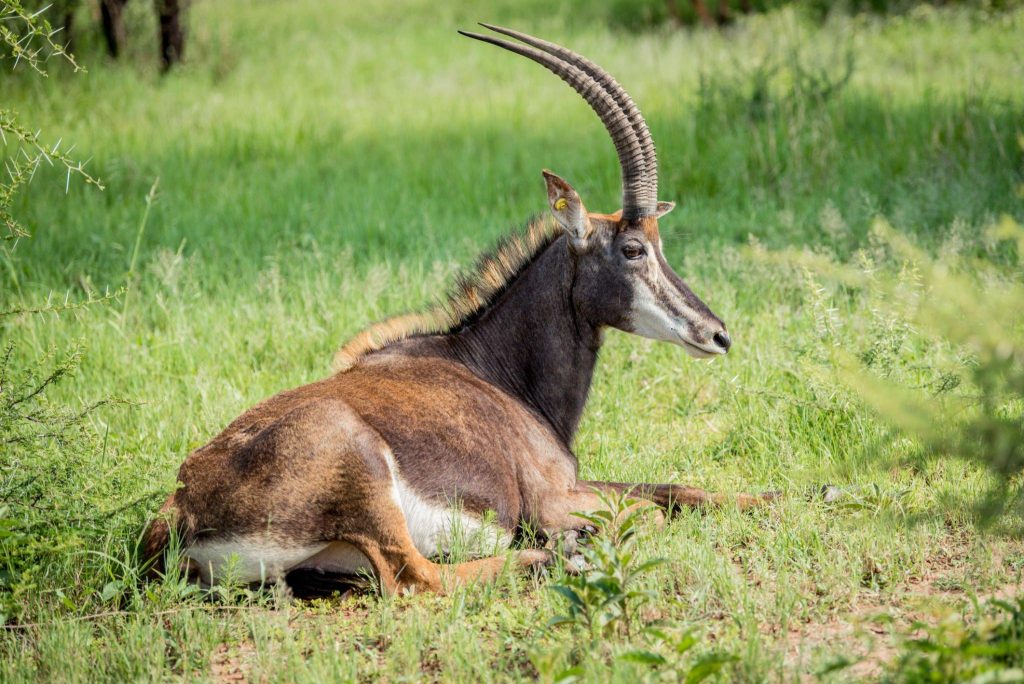
In the heart of Angola’s remote woodlands, a remarkable conservation success story unfolds: the rediscovery of the Giant Sable antelope. Once thought to have vanished from the Earth, this majestic creature has found sanctuary in the country’s vast landscapes.
The Giant Sable, scientifically known as Hippotragus niger variani, is a subspecies of the common sable antelope. With its striking appearance, characterized by long curved horns and a striking black coat with white markings, it’s no wonder this creature captured the imagination of conservationists and wildlife enthusiasts.
The journey to rediscovering the Giant Sable was one of determination, patience, and scientific dedication. After decades of uncertainty and lack of sightings, a small population was spotted in the wild in the early 2000s, triggering renewed hope for the species’ survival.
This discovery led to intensified conservation efforts, including habitat protection, anti-poaching measures, and scientific research.
Angola is Extremely Youthful
Angola, a nation pulsating with vitality, boasts a remarkably youthful population that shapes its dynamic trajectory. With a median age of approximately 16 years, the country stands as one of the youngest in the world.
This youthful demographic not only injects boundless energy into the cultural and social fabric but also signals a promising future of innovation and progress.
The exuberance of Angola’s youth is palpable in its cities, where bustling markets, thriving arts scenes, and a fervent embrace of technology mirror a nation on the cusp of transformation.
This youthful spirit also fuels a sense of resilience and adaptability, as the younger generation embraces opportunities with an eagerness to create positive change.
Angola is the Seventh Largest Country in Africa
Spanning an expansive land area, Angola proudly claims its position as the seventh largest country on the African continent. Encompassing over 1.2 million square kilometers of diverse terrain, Angola’s vast expanse showcases a myriad of landscapes, cultures, and traditions.
From the lush highlands to the arid deserts, this nation’s geographical diversity is matched only by its cultural richness. With a population that mirrors this vastness, Angola’s youthful spirit infuses its cities, towns, and rural areas alike.
This impressive size grants Angola a unique role in shaping the fabric of Africa’s identity, offering a canvas upon which history, innovation, and natural wonders converge.
As the seventh largest nation on the continent, Angola embodies the essence of Africa’s boundless potential, ready to share its beauty and aspirations with the world.
Angola is Home to a Pretty Impressive Waterfall
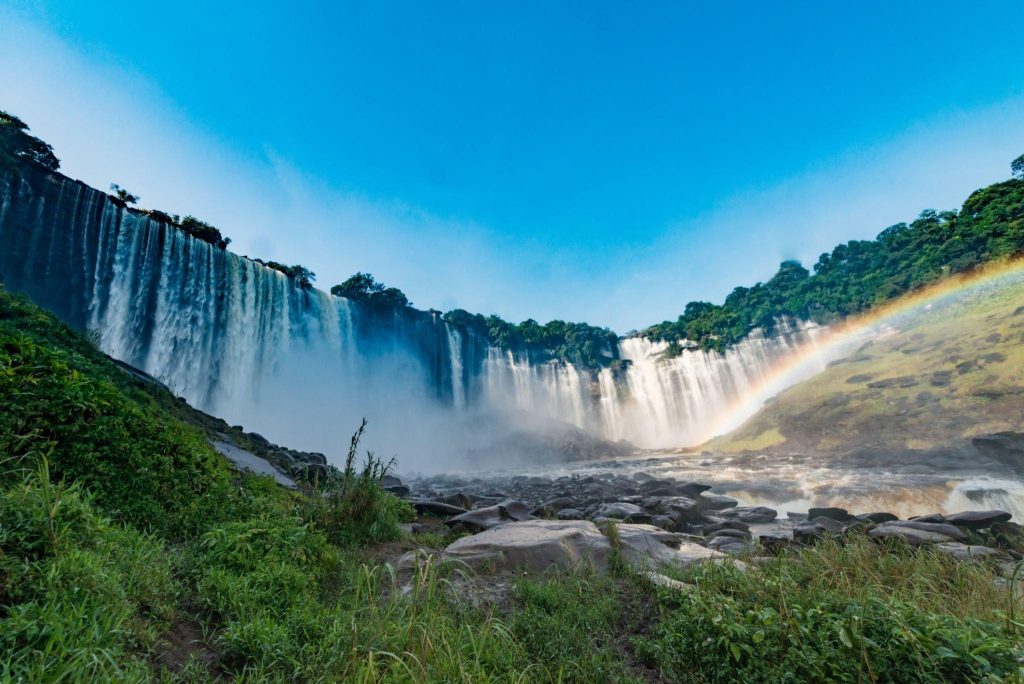
Nestled within the heart of Angola’s diverse landscape is a natural marvel that captivates with its sheer beauty and grandeur – the Kalandula Falls. Often referred to as the Duque de Bragança Falls, this awe-inspiring waterfall stands as one of Africa’s largest and most striking cascades.
Located on the Lucala River, the Kalandula Falls create a breathtaking spectacle as the water plunges over a series of rugged rock formations, creating a misty veil that adds to the enchantment.
The sheer scale of the falls is a sight to behold, with water cascading down a staggering drop that spans around 105 meters (344 feet) in height.
The resulting roar of water and the surrounding lush greenery create an atmosphere of serene natural beauty, offering a respite from the hustle and bustle of everyday life.
The falls are especially impressive during Angola’s rainy season, when the Lucala River swells, intensifying the cascading waters and adding to the drama of the landscape.
Exploring Luanda: The Capital City
Luanda, the vibrant capital city of Angola, is a captivating blend of history, culture, and modernity. Set against the backdrop of the Atlantic Ocean, this bustling metropolis offers a fascinating array of experiences for visitors to enjoy.
As you traverse its streets, you’ll encounter a unique fusion of architectural styles that reflect its colonial past and contemporary development.
The city’s historic quarter, known as the “Cidade Alta,” boasts charming Portuguese colonial buildings juxtaposed with modern skyscrapers. Luanda’s lively markets and vibrant street life provide glimpses into the daily rhythms of Angolan culture.
For those interested in history and culture, the National Museum of Slavery offers poignant insights into Angola’s past, particularly its role in the transatlantic slave trade.
The Museum of the Armed Forces delves into the nation’s struggle for independence and showcases military artifacts. Art aficionados will find delight in the Belas Art Gallery, which houses an impressive collection of Angolan and international artworks.
The Allure of Angolan Cuisine

Angolan cuisine is a tantalizing fusion of influences that reflect the nation’s history and culture. Drawing inspiration from African, Portuguese, and Brazilian culinary traditions, Angolan dishes are a captivating blend of flavors and techniques that appeal to the senses.
Seafood takes center stage due to Angola’s coastal location, gracing tables with dishes like “caldeirada,” a rich fish stew bursting with aromatic spices.
The national dish, “muamba de galinha,” showcases the intersection of cultures, featuring chicken stewed in palm oil and seasoned with tantalizing spices. “Funje,” a staple side dish made from cassava, perfectly complements these savory mains.
And no Angolan meal is complete without a taste of ‘cocada,’ a sweet coconut dessert that satisfies the sweet tooth. Beyond the gastronomic delights, sharing a meal in Angola is an intimate experience, fostering connections and a sense of community. If you’re interested in exploring more hidden culinary gems like ‘cocada,’ you might also want to discover Jersey’s hidden gems.
As you savor each bite, you’ll not only indulge in exquisite flavors but also embark on a culinary journey that unveils the heart and soul of Angola’s diverse heritage.
The Rhythms of Angolan Music and Dance
Angola’s cultural heartbeat resonates through its vibrant music and dance traditions, creating a symphony of rhythms that reflect the nation’s soul. Rooted in history and deeply embedded in daily life, Angolan music and dance are expressions of joy, resilience, and identity.
The country’s musical landscape is a diverse tapestry, encompassing genres like kizomba, semba, and kuduro. Kizomba’s sensual melodies and graceful movements speak of romance and human connection, while semba, often referred to as the “soul of Angola,” captures the essence of its people’s experiences.
Kuduro, on the other hand, is a modern fusion of electronic beats and energetic dance, representing contemporary urban culture. These musical genres have transcended borders, captivating global audiences and influencing international artists.
The rhythms of Angolan music and dance serve as a testament to the nation’s creativity, cultural heritage, and ability to unite people through the universal language of melody and movement.
Untapped Tourism Potential
Angola, with its breathtaking landscapes, diverse culture, and unique history, holds within its borders a vast reservoir of untapped tourism potential.
Despite its wealth of offerings, the country remains relatively unexplored by international travelers, presenting an exciting opportunity for those seeking authentic and off-the-beaten-path experiences.
From the sprawling national parks teeming with wildlife to the unspoiled beaches lining its coastline, Angola’s natural beauty is a canvas waiting to be explored. Its rich cultural heritage, a fusion of indigenous traditions and colonial influences, offers a captivating glimpse into the nation’s past and present.
The charm of Angola’s cities, with their vibrant markets, historic architecture, and bustling street life, adds another layer of intrigue to the country’s tourism potential.
As more adventurers begin to recognize the allure of this hidden gem, Angola stands poised to emerge as a destination that offers not only the joy of discovery but also the satisfaction of contributing to the growth of a nascent travel industry.
If you’re a traveler who craves unique experiences and vibrant destinations, consider exploring places like Las Vegas known for its Neon Lights and Glamour. Angola’s untapped beauty and Las Vegas’s iconic nightlife both await your discovery, promising unforgettable adventures that will leave a lasting mark on your travel memories.
Conclusion:
In conclusion, Angola’s fame is a symphony of natural wonders, cultural richness, and untapped potential. This Southern African nation holds a captivating allure for those seeking to venture off the beaten path and explore landscapes that range from lunar-like viewpoints to stunning beaches.
The rediscovery of the giant sable antelope stands as a testament to Angola’s commitment to conservation and showcases its dedication to preserving its unique wildlife heritage.
With its youthful population and expansive territory, Angola offers a vibrant blend of traditions, languages, and lifestyles. The majestic Kalandula Falls and the rhythmic beats of Angolan music reflect the diverse tapestry of experiences that await travelers.

